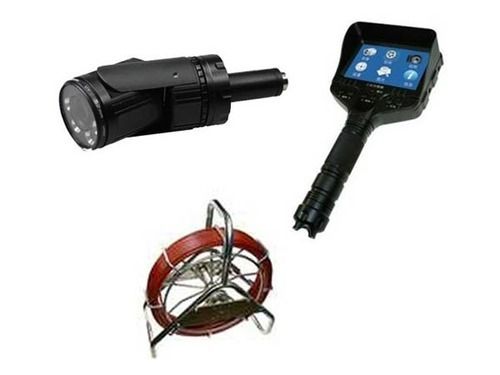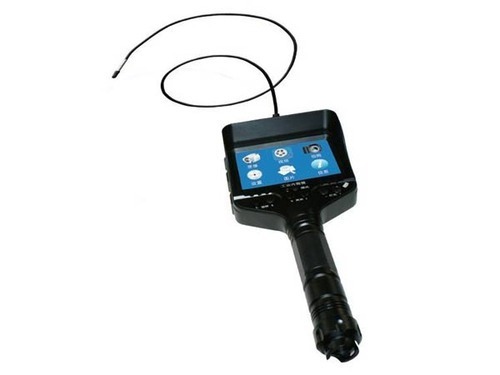Industrial Pipeline Endoscope
10000 INR/Unit
Product Details:
- Power Supply Electric
- Usage Measuring Tools
- Product Type Industrial Pipeline Endoscope
- Application Testing & Measurement
- Color Black
- Material Mild Steel
- Click to View more
X
Industrial Pipeline Endoscope Price And Quantity
- 10000 INR/Unit
- 1 Unit
Industrial Pipeline Endoscope Product Specifications
- Industrial Pipeline Endoscope
- Measuring Tools
- Electric
- Mild Steel
- Black
- Testing & Measurement
Industrial Pipeline Endoscope Trade Information
- 100 Unit Per Week
- 1 Week
- All India
Product Description
A pipeline endoscope, also known as a sewer inspection camera or pipeline inspection camera, is a specialized tool used for examining the interior of pipes, conduits, and other narrow passages. It typically consists of a high-resolution camera mounted on a flexible cable or rigid rod that can be inserted into the pipe. The camera captures live video footage or images of the interior of the pipeline, allowing inspectors to assess its condition, identify blockages, leaks, cracks, corrosion, or other issues.
Other Details:
- Standard Configuration:M-55ES Endoscope 15 inch touch screen & high resolution of TFT-LCD 1
- Li Rechargeable Batteries 2 AC adapter 1 USB Cable 1 Plastic Tool Case 1 Manual
- 20 Meter Reels (30 meter, 60 meter is optional)
- Ultra-thin metal shell, weight 0.68 kg, can work in the sunshine with hood
- Screen, Resolution 800*480.
- Recording while detecting, support video playback
- Enlist operating system and USB 2.0 interface, plug & play
- Rechargeable Li-Battery lasts 7-8 hours
- Probe Diameter: 55 mm
- Probe Length: 170 mm
- Camera Direction: Front View, 2 way direction
- Visual Angle: 90/360 Rotating
- Focus: Electronic Focusing, 10 times optical zoom
- Lighting: LED light
- Camera: Color CCD
- Resolution: 480000 pixels
- Waterproof: IP60
- Best operating tube: 80 mm -2000 mm
- Wording Temperature: -10-50
Pipeline endoscopes are commonly used in various industries, including:
1. Municipalities and Utilities: Inspecting sewer lines and stormwater drains to detect clogs, damage, or structural issues that could lead to leaks or backups.
2. Construction and Engineering: Assessing the integrity of newly installed pipes or conduits before they are put into service, as well as inspecting existing infrastructure during maintenance or renovation projects.
3. Oil and Gas: Checking the condition of pipelines used for transporting oil, gas, or other fluids to ensure safety and prevent leaks or environmental damage.
4. Manufacturing: Examining the interior of pipes and machinery in manufacturing plants to monitor for wear and tear, corrosion, or other issues that could affect production efficiency or product quality.
Industrial Pipeline Endoscope Specifications:
1. Brand: Pro
2. Ultra-thin Metal Shell Weight: 0.68 kg
3. Resolution: 800x480 mm
4. Power Source: Battery
5. Model No: PRO-UR-VT-M
Pipeline Endoscope FAQ:
Q. What is a pipeline endoscope?
Ans: A pipeline endoscope, also known as a sewer inspection camera or pipeline inspection camera, is a specialized tool used for examining the interior of pipes, conduits, and other narrow passages. It typically consists of a high-resolution camera mounted on a flexible cable or rigid rod.
Q. How does a pipeline endoscope work?
Ans: A pipeline endoscope is inserted into the pipe or conduit, and the camera captures live video footage or images of the interior. This footage is transmitted to a monitor or display unit for real-time viewing. The endoscope may be equipped with LED lights for illumination and other features to enhance visibility.
Q. What are the applications of pipeline endoscopes?
Ans: Pipeline endoscopes are used in various industries, including municipalities and utilities for inspecting sewer lines, construction and engineering for assessing pipeline integrity, oil and gas for checking pipeline condition, and manufacturing for examining machinery and pipes.
Q. What are the benefits of using a pipeline endoscope?
Ans: Pipeline endoscopes allow inspectors to visually inspect the interior of pipes without the need for costly and invasive excavation or dismantling. They can identify issues such as blockages, leaks, cracks, corrosion, or other damage, enabling proactive maintenance and repairs.
Q. What features should I look for in a pipeline endoscope?
Ans: Important features to consider include camera resolution, cable length and flexibility, illumination (LED lights), recording capability, tilt and pan functions for better viewing angles, and compatibility with different pipe sizes and materials.
Q. How do I choose the right pipeline endoscope for my needs?
Ans: Consider factors such as the diameter and material of the pipes you need to inspect, the length of the inspection cable required, the level of image clarity needed for your inspections, and any specific features or accessories that may enhance usability or functionality.
Q. Are pipeline endoscopes easy to use?
Ans: Pipeline endoscopes are designed to be user-friendly, with intuitive controls and straightforward operation. However, proper training and familiarity with the equipment are essential to ensure accurate and effective inspections.
Q. Can pipeline endoscopes be used for preventive maintenance?
Ans: Yes, pipeline endoscopes are commonly used for preventive maintenance to detect potential issues before they escalate into more significant problems. Regular inspections can help prolong the lifespan of pipelines and prevent costly repairs or downtime.
Q. What safety precautions should be taken when using a pipeline endoscope?
Ans: Safety precautions may include wearing appropriate personal protective equipment (PPE), ensuring proper ventilation in confined spaces, securing the inspection area to prevent accidents, and following manufacturer guidelines for equipment use and maintenance.
Q. Can pipeline endoscope inspections be recorded or documented?
Ans: Many pipeline endoscopes are equipped with recording capabilities, allowing inspections to be documented for future reference or analysis. Recorded footage or images can also be useful for reporting findings to stakeholders or regulatory authorities.
Tell us about your requirement

Price:
Quantity
Select Unit
- 50
- 100
- 200
- 250
- 500
- 1000+
Additional detail
Mobile number
Email
 English
English Spanish
Spanish French
French German
German Italian
Italian Chinese (Simplified)
Chinese (Simplified) Japanese
Japanese Korean
Korean Arabic
Arabic Portuguese
Portuguese






 Call Me Free
Call Me Free
